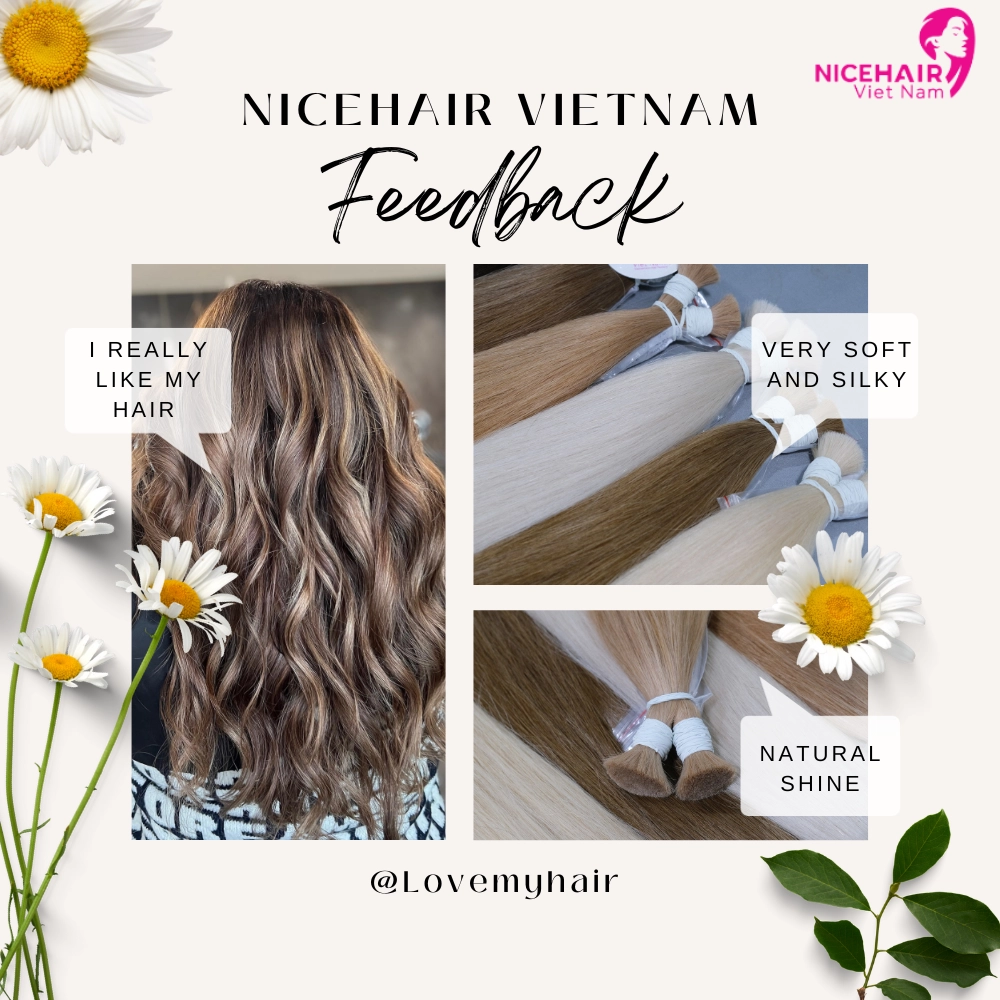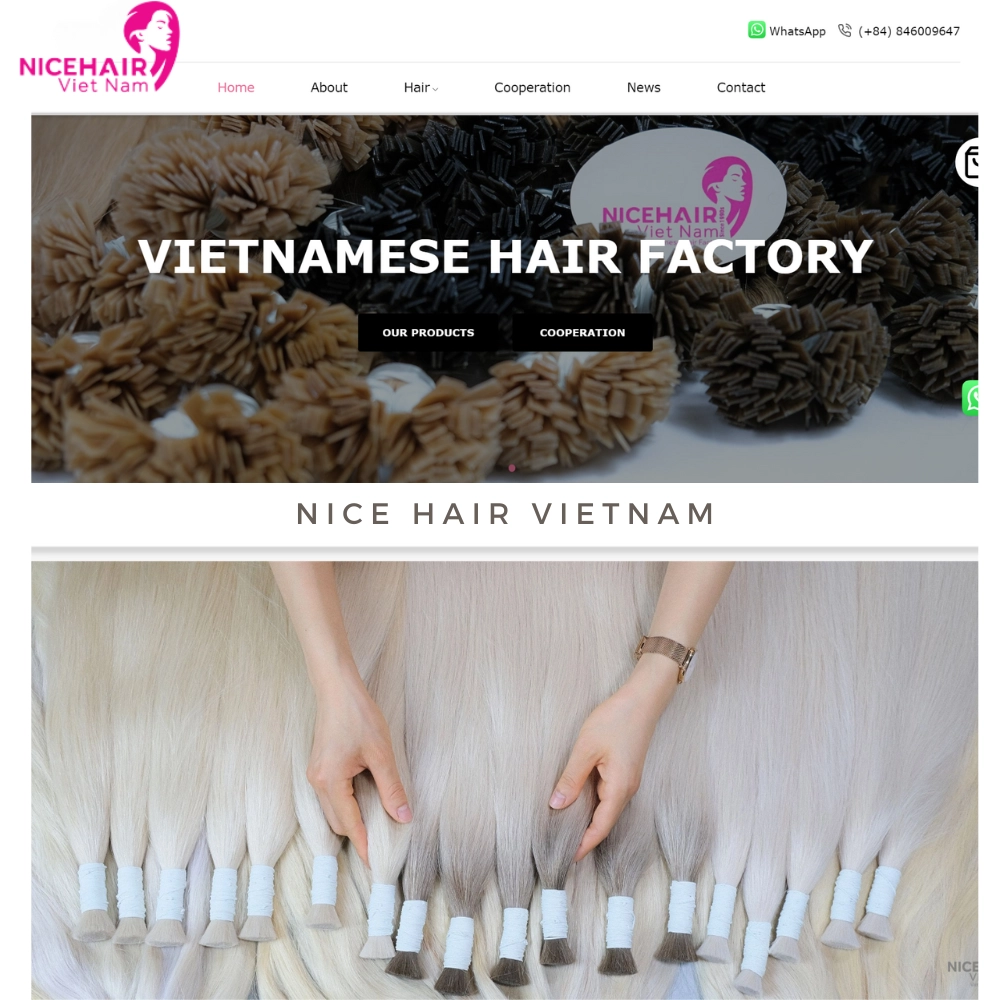Introduction
In the fast-paced and ever-evolving world of beauty and fashion, the significance of strategic expansion holds profound implications for wholesale hair vendors. This industry thrives on innovation, trends, and consumer preferences, making strategic expansion a cornerstone for setting the stage for growth and market expansion. In this article, we will explore why strategic expansion is crucial for wholesale hair vendors and how it plays a pivotal role in shaping their success in this dynamic marketplace.
The competitive market
Wholesale hair vendors operate in a highly competitive market. The demand for quality hair extensions, wigs, and related products is incessant, but so is the competition. To remain relevant and thrive, vendors must not only provide top-tier products but also employ strategic expansion as a means to distinguish themselves in this crowded marketplace.
Diversification of product offerings
One key facet of strategic expansion is diversifying product offerings. While the core products of hair extensions and wigs are essential, wholesale hair vendors can strengthen their market presence by expanding their range to include complementary items such as hair care products, styling tools, and accessories. By doing so, they not only meet the diverse needs of their customers but also boost their appeal as comprehensive hair solution providers.
Market reach and geographical expansion
Strategic expansion is a gateway to reaching new markets. Wholesale hair vendors can significantly amplify their growth prospects by venturing into new geographical territories, whether regionally or internationally. Different regions often have distinct preferences and trends in hair styling and beauty. By understanding and catering to these nuances, vendors can position themselves as go-to sources for products that align with local tastes and preferences.
Strengthening distribution channels
Distribution channels are the arteries through which products flow from vendors to consumers. Effective strategic expansion involves strengthening these channels. Building robust partnerships with retailers, salons, and e-commerce platforms not only extends a vendor’s reach but also streamlines the distribution process, ensuring that products reach consumers efficiently and promptly.
Innovation and research & development
Innovation is the lifeblood of the beauty industry, and wholesale hair vendors are no exception. To stay ahead, vendors must invest in research and development (R&D) to continuously improve and innovate their product lines. Strategic expansion into R&D fosters the creation of cutting-edge products, attracting both loyal customers and new clientele. It’s an investment that ensures long-term relevance and competitiveness.
Assessing current business performance for wholesale hair vendors

To thrive in this market, it is essential for wholesale hair vendors to continually assess their current business performance. By reviewing financial data, sales metrics, customer feedback, and market trends, wholesale hair vendors can identify areas for improvement and growth potential, ensuring their long-term success in the industry.
Reviewing financial data and sales metrics
One of the first steps in assessing the performance of a wholesale hair vendor is to review their financial data and sales metrics. This involves a comprehensive analysis of revenue, profit margins, and expenses. By delving into the numbers, wholesale hair suppliers can gain valuable insights into their financial health and operational efficiency.
- Revenue analysis: Examining revenue trends over time can reveal whether the business is growing, stagnant, or declining. Wholesale hair vendors can track sales by product category, allowing them to identify which hair products are performing well and which may need adjustments.
- Profit margins: Analyzing profit margins is crucial for understanding the overall profitability of the business. Wholesale hair suppliers must assess whether their pricing strategies are sustainable and if there is room for improvement in their cost structures.
- Expense evaluation: Identifying areas of excessive spending or inefficient cost allocation is vital. Reducing unnecessary expenses can contribute significantly to profitability.
Identifying areas for improvement and growth potential
After analyzing financial data, wholesale hair vendors can pinpoint areas for improvement and growth potential within their business operations.
- Product diversification: Based on sales metrics, vendors can decide whether to expand their product offerings or focus on specific product categories that are more lucrative. Diversifying product lines can attract a broader customer base.
- Supply chain efficiency: Assessing the supply chain for bottlenecks and inefficiencies can help streamline operations, reduce lead times, and lower costs. Improved supply chain management can also enhance customer satisfaction.
- Market expansion: Reviewing sales data can reveal untapped geographic markets or customer segments. Wholesale hair vendors may consider expanding into new regions or targeting a different demographic to increase their market share.
Analyzing customer feedback and market trends
In addition to financial metrics, customer feedback and market trends are invaluable sources of information for wholesale hair vendors.
- Customer feedback: Soliciting and analyzing customer feedback provides insights into product quality, customer service, and overall satisfaction. Addressing customer concerns and making necessary improvements can enhance loyalty and repeat business.
- Market trends: Staying up-to-date with industry trends is crucial. Wholesale hair vendors should keep a close eye on emerging trends in haircare, styling, and consumer preferences. Adapting to these trends can keep a business relevant and competitive.
Expanding and innovating hair product lines for wholesale hair vendors

Expanding hair product lines
Adding new types of hair extensions and weaves
Wholesale hair vendors can captivate their customers’ attention by continually adding new types of hair extensions and weaves to their product lines. Diverse hair textures, lengths, and styles are essential to cater to a broad range of customers, from those seeking volume and length to those interested in unique and fashionable looks. By staying on top of the latest hair trends and incorporating them into their product catalog, wholesale hair suppliers can attract more customers and increase sales.
Exploring different textures and lengths
Hair extensions and weaves come in a plethora of textures and lengths, and it’s vital for wholesale hair vendors to offer a wide variety. From straight and wavy to curly and kinky, there are endless possibilities to cater to various hair types and styling preferences. Offering different lengths allows customers to experiment with short or long hair without making a long-term commitment. By providing options that cater to every hair type and style preference, wholesale hair suppliers can tap into new customer segments and drive growth.
Staying updated with hair fashion trends
The world of hair fashion is always evolving, with new trends emerging regularly. Wholesale hair vendors must keep their fingers on the pulse of the latest styles and trends. By offering products that align with current fashion trends, such as trendy colors or innovative hair extension techniques, they can position themselves as trendsetters and attract fashion-forward customers. Regularly updating product lines to reflect these trends keeps the business competitive and ensures it remains a go-to destination for stylists and consumers seeking the latest in hair fashion.
Exploring complementary products
Introducing hair care products and accessories
To enhance the overall customer experience and provide value beyond just hair extensions and weaves, wholesale hair vendors can introduce a range of complementary products. This may include hair care products such as shampoos, conditioners, and styling products specifically designed for hair extensions. Additionally, offering a selection of accessories like hairpins, clips, and brushes can create a one-stop shopping experience for customers. These added products not only increase revenue but also foster customer loyalty.
Identifying products that enhance the customer experience
Beyond just adding any products, wholesale hair suppliers should identify those that truly enhance the customer experience. This could involve researching and sourcing high-quality products that address common challenges associated with hair extensions and weaves, such as maintaining their natural appearance and durability. By offering solutions to these issues, wholesale hair vendors can build trust with their customers and stand out in the market.
Maximizing online presence and E-commerce for wholesale hair vendors
Enhancing online presence and E-commerce
Developing a user-friendly e-commerce website
A user-friendly e-commerce website is the cornerstone of a successful online presence for wholesale hair vendors. It should be visually appealing, easy to navigate, and offer a seamless shopping experience. Ensure that customers can browse product catalogs, access detailed product information, and make secure transactions effortlessly. Mobile optimization is crucial since many shoppers use smartphones for online purchases.
Implementing a robust search function, categorizing products effectively, and incorporating customer reviews and ratings can help buyers find the right products quickly. Regularly updating the website with new products and trends keeps customers engaged and encourages return visits.
Implementing online marketing strategies
Online marketing plays a pivotal role in attracting and retaining customers. Wholesale hair vendors should invest in search engine optimization (SEO) to improve their website’s visibility on search engines like Google. Pay-per-click (PPC) advertising and email marketing campaigns can target potential customers effectively.
Content marketing, such as creating blog posts or videos related to hair care and styling, establishes the vendor as an authority in the industry and attracts organic traffic. Leveraging data analytics and tracking tools helps in evaluating the effectiveness of online marketing strategies and making data-driven adjustments.
Leveraging social media and online marketplaces
Social media platforms like Instagram, Facebook, and Tiktok are excellent tools for wholesale hair vendors to showcase their products, engage with customers, and build a loyal following. Regular posts featuring high-quality images and videos can help demonstrate the versatility and quality of the hair extensions and weaves offered.
Additionally, online marketplaces like Lazada and Tiki provide access to a vast customer base. By listing products on these platforms, wholesale hair suppliers can tap into new markets and reach a wider audience. Maintaining a consistent brand presence across social media and online marketplaces helps build trust and recognition.
Exploring new retail partnerships
Forging collaborations with salons and beauty supply stores
Collaborating with local salons and beauty supply stores is a strategic move for wholesale hair vendors. These establishments often serve as trusted sources for hair care products, and by establishing partnerships, vendors can gain access to a ready-made customer base. Offer exclusive discounts or promotions to salon customers to incentivize purchases.
Negotiating distribution agreements with retailers
Wholesale hair vendors can negotiate distribution agreements with retailers to have their products featured prominently in physical stores. These agreements can include cooperative marketing efforts and branding initiatives to enhance product visibility. This strategy not only boosts sales but also strengthens brand recognition.
Establishing a wholesale network
Building a wholesale network involves partnering with other businesses in the industry, such as distributors, wholesalers, or even manufacturers of complementary products like hair care items. By creating a network of trusted partners, wholesale hair suppliers can access new channels for distribution, reduce costs, and extend their reach into various markets.
Marketing and promotion strategies for wholesale hair vendors

Crafting a marketing plan
Defining target audiences
Understanding your target audience is the foundation of any successful marketing strategy. Wholesale hair vendors should conduct market research to identify their ideal customers. This involves considering factors such as age, gender, location, hair type, and style preferences. By defining your target audience, you can tailor your marketing efforts to better meet their needs and preferences.
Allocating a marketing budget
A well-defined marketing budget is essential to ensure that your promotional efforts are both effective and sustainable. Allocate your budget wisely across various marketing channels, considering the cost-effectiveness and potential return on investment (ROI) of each channel. This might include online advertising, social media campaigns, trade shows, or traditional advertising methods.
Leveraging various marketing channels
In the digital age, wholesale hair vendors have a multitude of marketing channels at their disposal. These include:
- Social media: Utilize platforms like Instagram, Facebook, and Pinterest to showcase your products through engaging visuals and customer testimonials. Regularly updated social media profiles can help build a loyal following.
- Email marketing: Build and nurture your customer database through email marketing campaigns. Send out newsletters with product updates, promotions, and educational content related to hair care.
- Search engine optimization (SEO): Optimize your website for search engines to improve your online visibility. This involves using relevant keywords, creating high-quality content, and ensuring your website is mobile-friendly.
- Content marketing: Create blog posts, videos, and tutorials that provide valuable information about hair care and styling. This not only positions your brand as an authority in the field but also attracts organic traffic to your website.
Enhancing branding and image
- Evolving the brand identity: A strong brand identity sets you apart from the competition. Reevaluate and, if necessary, evolve your brand identity to reflect your unique selling proposition (USP) and resonate with your target audience. Consider elements such as your brand’s name, logo, colors, and messaging.
- Improving packaging and presentation: The packaging of your hair products plays a significant role in customer perception. Consider investing in attractive, informative packaging that highlights the quality and features of your products. Clear labeling and packaging that communicates the benefits of your hair extensions and weaves can make a significant impact.
- Incorporating sustainability and ethical values: Many consumers today are conscious of sustainability and ethical values. If your business practices align with these values, make it a focal point of your branding. Highlight eco-friendly packaging, cruelty-free product testing, or fair trade sourcing in your marketing materials to attract environmentally and socially conscious customers.
Financial considerations for wholesale hair vendors
Securing financing for expansion
Exploring funding options
- Traditional loans: Wholesale hair vendors looking to expand their operations can explore traditional lending options such as bank loans or credit lines. These options often offer lower interest rates compared to alternative sources of financing, making them an attractive choice for well-established businesses with a strong credit history.
- Venture capital and investors: For startups or companies with high growth potential, seeking venture capital or private investors can be a viable option. However, this often involves giving up a portion of ownership and requires a compelling business plan and growth strategy.
- Crowdfunding: Crowdfunding platforms like Kickstarter or Indiegogo have become increasingly popular for raising capital. This method allows businesses to secure funds from a large number of backers, often in exchange for early product access or rewards.
- Small business grants: Researching and applying for small business grants from government agencies or private organizations can be a valuable source of non-repayable funding for expansion.
Managing cash flow during expansion
Expanding a wholesale hair vendor business can put a strain on cash flow, as it involves upfront costs for inventory, marketing, and potentially hiring additional staff. To manage cash flow effectively:
- Cash flow forecasting: Create detailed cash flow projections that outline expected income and expenses during the expansion period. This can help you anticipate any potential shortfalls and make necessary adjustments.
- Inventory management: Ensure that your inventory is managed efficiently. Overstocking can tie up capital, while understocking can lead to missed sales opportunities. Implement inventory management systems to strike the right balance.
Budgeting and forecasting
Creating a detailed financial plan
- Start with a business plan: A comprehensive business plan should include a financial section that outlines your goals, strategies, and anticipated financial performance. This serves as a roadmap for your business.
- Sales forecast: Accurately project your sales by analyzing historical data, market trends, and your expansion plans. A well-reasoned sales forecast is essential for setting realistic revenue goals.
Setting revenue and expense goals
- Expense control: Identify and categorize your expenses, differentiating between fixed and variable costs. Create a budget that allows for cost control while still accommodating necessary expenditures for expansion.
- Revenue diversification: Explore ways to diversify your revenue streams. For wholesale hair vendors, this could involve expanding product lines, exploring new markets, or strengthening customer relationships.
- Emergency fund: Prepare for unexpected financial challenges by setting aside a portion of your profits as an emergency fund. This buffer can help you weather unforeseen setbacks without jeopardizing your expansion plans.
Overcoming challenges for wholesale hair vendors

Common expansion challenges
- Maintaining product quality and consistency: One of the biggest challenges for wholesale hair vendors is preserving the quality and consistency of their products, especially when expanding their offerings or scaling up production. Any compromise in quality can tarnish a vendor’s reputation and lead to a loss of trust among customers.
- Managing increased demand and supply chain complexities: As wholesale hair vendors grow, they often experience higher demand for their products. This increased demand can strain supply chains, leading to potential delays, inventory issues, and logistical complexities. Managing these complexities effectively is crucial to sustaining expansion.
- Staying competitive in a crowded market: The wholesale hair industry is saturated with competitors offering a wide range of products. Staying competitive in this crowded market can be challenging, especially for vendors looking to expand their reach and capture a larger market share.
Mitigation strategies for challenges
- Quality control measures and product testing: To address the challenge of maintaining product quality and consistency, wholesale hair vendors should implement stringent quality control measures. This includes rigorous product testing at various stages of production to ensure that each item meets the specified standards. Investing in quality control not only maintains customer trust but also reduces the risk of costly recalls or returns.
- Continuous market research and adaptation: Successful wholesale hair vendors recognize the importance of staying up-to-date with market trends and customer preferences. Conducting regular market research allows vendors to adapt their product offerings and marketing strategies to meet evolving customer demands. This might involve introducing new products, improving existing ones, or refining pricing strategies.
- Investing in technology and automation: Supply chain complexities can be mitigated by embracing technology and automation. Inventory management systems, order processing software, and predictive analytics can streamline operations, improve inventory control, and enhance supply chain visibility. These technologies not only help manage increased demand but also enable scalability without sacrificing efficiency.
- Effective marketing and branding: To stand out in a crowded market, wholesale hair vendors must invest in effective marketing and branding efforts. This includes creating a compelling brand identity, leveraging social media and e-commerce platforms, and engaging with customers through targeted advertising and promotions.
- Strategic partnerships and alliances: Collaborating with other businesses in the beauty and fashion industry can be a strategic move for wholesale hair vendors. Partnerships can help vendors expand their distribution networks, reach new customer segments, and enhance their brand presence.
Monitoring and measuring success for wholesale hair vendors
Key performance indicators (KPIs)
Tracking relevant KPIs for growth
- Sales revenue and profit margins: Tracking sales revenue and profit margins is fundamental. This helps wholesale hair vendors understand their financial health and profitability. Analyzing trends and patterns in revenue and margins can provide insights into pricing strategies and market demand.
- Inventory turnover rate: Efficient inventory management is crucial. Calculating the inventory turnover rate reveals how quickly products are sold and replenished. A high turnover rate suggests strong demand and efficient operations.
- Customer acquisition and retention: Measuring the number of new customers acquired and the rate of customer retention can gauge the effectiveness of marketing and customer service efforts. Loyal customers often contribute significantly to a vendor’s long-term success.
- Customer feedback and satisfaction: Soliciting feedback from customers and measuring their satisfaction levels can highlight areas for improvement. Customer satisfaction KPIs can include Net Promoter Score (NPS) or Customer Satisfaction Score (CSAT).
Making data-driven decisions
- Data analytics tools: Invest in data analytics tools and systems to collect, analyze, and interpret data efficiently. These tools can help uncover hidden trends and opportunities within your business operations.
- Regular performance reviews: Schedule regular reviews to discuss KPIs and performance metrics with your team. Encourage open discussions on how to improve and capitalize on strengths.
Setting milestones and goals
Defining short-term and long-term expansion goals
- Short-term goals: Short-term goals should be specific, measurable, achievable, relevant, and time-bound (SMART). Examples include increasing monthly sales by a certain percentage, reducing operating costs, or launching a new product line within a defined timeframe.
- Long-term goals: Long-term goals provide a vision for the future. They could encompass objectives like expanding into new markets, becoming a recognized industry leader, or achieving a specific market share over several years.
- Break down goals: Break down long-term goals into manageable milestones. For instance, if your long-term goal is to expand into international markets, a milestone might involve identifying potential markets and partners within the next 12 months.
Celebrating achievements and milestones
- Recognize achievements: Celebrate both small and significant achievements along the way. Acknowledging the efforts of your team and the progress made boosts morale and motivates everyone to work towards the next milestone.
- Adjust and reevaluate: As you achieve milestones, revisit your strategies and goals. Adjust them as needed to reflect changing market conditions, customer preferences, or internal capabilities.

